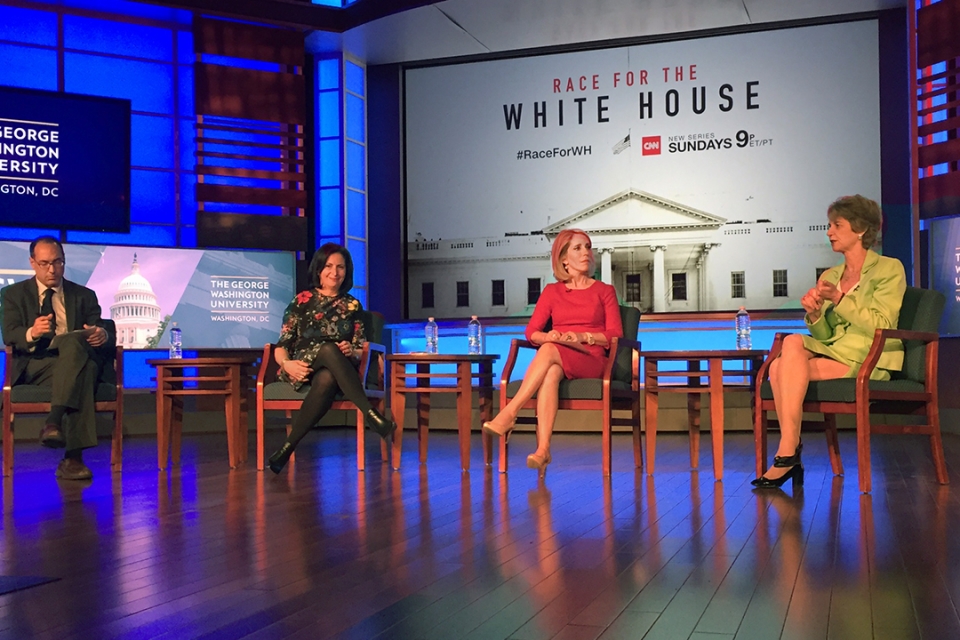By James Irwin
It was supposed to be the night when Richard Nixon, vice president of the United States, reestablished control in the race for the White House. He would demonstrate his qualifications, prove the inexperience of his challenger and overcome the tactical mistakes that had plagued his campaign to that point.
It turned out to be a mismatch.
Mr. Nixon looked sweaty, pale and uncomfortable, while John F. Kennedy seemed fresh, cool and presidential on Sept. 26, 1960, when the two candidates met in Chicago for the first televised presidential debate. Seven weeks later, Mr. Kennedy was president-elect, having won one of the closest national elections in U.S. history.
The debate demonstrated the power of television in shaping an election, said CNN Chief Political Correspondent Dana Bash, B.A. ’93.
“People listening to the radio thought Nixon won the debate and people watching TV thought Kennedy won,” she said Thursday at the George Washington University.
Mr. Nixon’s famously harried appearance on national TV was the most famous moment from the 1960 campaign. On Thursday, a panel moderated by Ms. Bash revisited that election at a special screening of the CNN documentary series “Race for the White House,” hosted by the School of Media and Public Affairs.
Nixon mistakes and Kennedy success
To believe the race was won and lost at that first debate is an oversimplification, according to the film. There were several pivotal points that highlighted Nixon miscues and Kennedy savvy.
Mr. Nixon infamously pledged to visit all 50 states during the 1960 campaign, an ambitious and grueling plan that exhausted him by the fall. He was hospitalized for two weeks in September after banging his knee on a car door and contracting an infection. A feverish and recovering Nixon banged the same knee on his way to the studio the night of the first debate and then declined to apply makeup for his hour on TV.
Mr. Kennedy had his own issues. He was too young and too inexperienced to be president, his detractors said. He also was Catholic. Mr. Kennedy delivered a speech to the Greater Houston Ministerial Association that attempted to address concerns of the Protestant clergy. It was a powerful speech, but the Catholic issue loomed large, said Kathleen Kennedy Townsend, former lieutenant governor of Maryland and daughter of Mr. Kennedy’s brother, Robert F. Kennedy.
“Many people were very scared of electing a Catholic president,” she said. “The largest allocation of money spent in the 1960 campaign was reproducing the transcript of [John’s] talk to the ministers. They sent it all across the country.”
Perhaps the most critical moment of the campaign came a month after that speech, when Martin Luther King Jr. was arrested at a restaurant sit-in less than three weeks before Election Day. Mr. Nixon attempted to secure Dr. King’s release through the White House. He failed, foiled by his own apparatus.
The Kennedys opted for a different approach. Kennedy adviser Sargent Shriver passed along a recommendation that Mr. Kennedy call Dr. King’s wife, Coretta, to express sympathy. Later, Robert Kennedy called the judge who sentenced Dr. King, asking for his release.
“He realized it was better to call the judge,” Ms. Kennedy Townsend said. “Richard Nixon tried to work through the White House, and it wasn’t their job. My father was smart enough to call the judge.”
The candidate’s image
Television framed the race. More than 70 million people watched the first Kennedy-Nixon debate.
“It’s monumental to think that many people watched,” said Amy Entelis, executive vice president for talent and content development for CNN Worldwide. “Even today I think the biggest debates are around 25 million people. It’s amazing to think about the degree of interest in that campaign.”
Mr. Kennedy used television more effectively than Mr. Nixon—and not just on the debate stage—said Matt Dallek, assistant professor at the Graduate School of Political Management. Despite suffering from Addison's disease and other physical maladies, the Kennedy campaign portrayed its candidate as young and energetic. They had catchy jingles, a glamorous couple and Frank Sinatra.
“Kennedy was a draw, there was a certain magnetism to him,” Dr. Dallek said. “And there was an idealism that he was able to channel in that 1960 campaign.”
It helped him win the White House, Ms. Bash said.
“They were gorgeous and they were young and they were fashionable and different than the way politicians looked at the time,” she said of the Kennedys. “Just to see the juxtaposition of Kennedy, and poor Nixon—who is banging his knee into the door and has to be in the hospital for two weeks—is powerful.”
This article and photo was originally published by GW Today.


